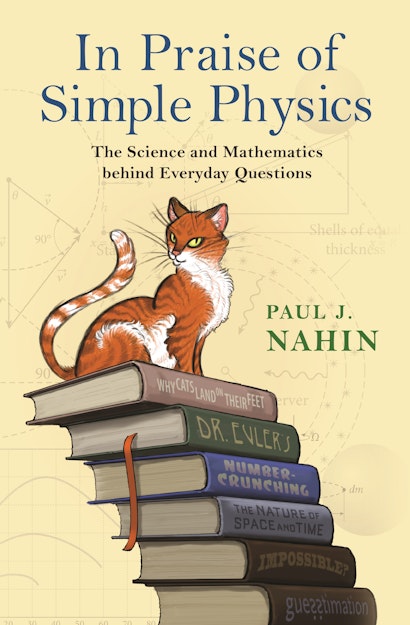Physics can explain many of the things that we commonly encounter. It can tell us why the night is dark, what causes the tides, and even how best to catch a baseball. With In Praise of Simple Physics, popular math and science writer Paul Nahin presents a plethora of situations that explore the science and math behind the wonders of everyday life. Roaming through a diverse range of puzzles, he illustrates how physics shows us ways to wring more energy from renewable sources, to measure the gravity in our car garages, to figure out which of three light switches in the basement controls the light bulb in the attic, and much, much more.
How fast can you travel from London to Paris? How do scientists calculate the energy of an atomic bomb explosion? How do you kick a football so it stays in the air and goes a long way downfield? Nahin begins with simpler problems and progresses to more challenging questions, and his entertaining, accessible, and scientifically and mathematically informed explanations are all punctuated by his trademark humor. Readers are presumed to have some background in beginning differential and integral calculus. Whether you simply have a personal interest in physics’ influence in the world or you’re an engineering and science student who wants to gain more physics know-how, this book has an intriguing scenario for you.
In Praise of Simple Physics proves that if we look carefully at the world around us, physics has answers for the most astonishing day-to-day occurrences.
Paul J. Nahin is professor emeritus of electrical engineering at the University of New Hampshire. He is the author of many best-selling popular math books, including Digital Dice, Chases and Escapes, Dr. Euler's Fabulous Formula, When Least Is Best, Duelling Idiots and Other Probability Puzzlers, and An Imaginary Tale (all Princeton).
"The energy of moving water, the physics of communication satellites and the maths behind catching a ball are all skilfully dissected by engineer and writer Paul Nahin in this enjoyable study of everyday physics."—Nature
"Nahin's writing style, as in previous books, is clear, conversational, humorous and chatty. . . . [A]nd the discussions in the book are careful and appropriately rigorous."—MAA Reviews
"Fun, accessible physics/math problems along with some humor."—Antonio Cangiano, Math-Blog
"[Nahin] knows how to catch the attention of his reader. You will not regret buying any of his books, and I am sure after reading it, you will pick up this one to check again on one of his models and his solution methods."—European Mathematical Society
"A superb book. . . . [D]emonstrates clever ways to solve simply physics problems."—Choice
"Praise for the previous edition: "Fun, accessible physics [and] math problems along with some humor.""—Math-Blog
"In Praise of Simple Physics offers a masterful look at how basic principles, combined with clever thinking and fundamental mathematics, lead to satisfying explanations of an extraordinary range of natural phenomena, from the path of a football to why the sky is dark at night. Nahin's humor and accessible examples shine. Celebrate your curiosity and delve into this magnificent book!"—Paul Halpern, author of Einstein's Dice and Schrödinger's Cat
"In Praise of Simple Physics is a must-read for anyone curious about how physics shows up in everyday life. Paul Nahin's clear explanations demystify the mathematics behind the physics, and with over two dozen applications, his book is a great introduction to mathematical modeling as well."—Oscar Fernandez, author of Everyday Calculus
"This is a superb book—thoughtful, historical, carefully done, and intensely clever. It was a joy to read."—Christopher G. Tully, Princeton University
"Many books that explore classical physics problems tend to be relentlessly sequential and completely humorless. In this book, Paul Nahin shows a lighter touch and he gives himself the necessary space to tell the mathematical story. The book encourages readers to engage with the less-than-obvious aspects of physics."—Jens Zorn, professor emeritus of physics, University of Michigan


